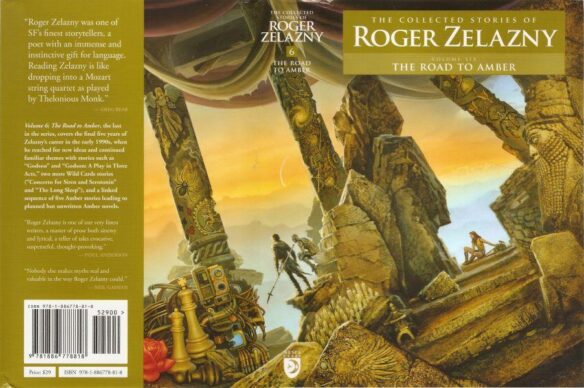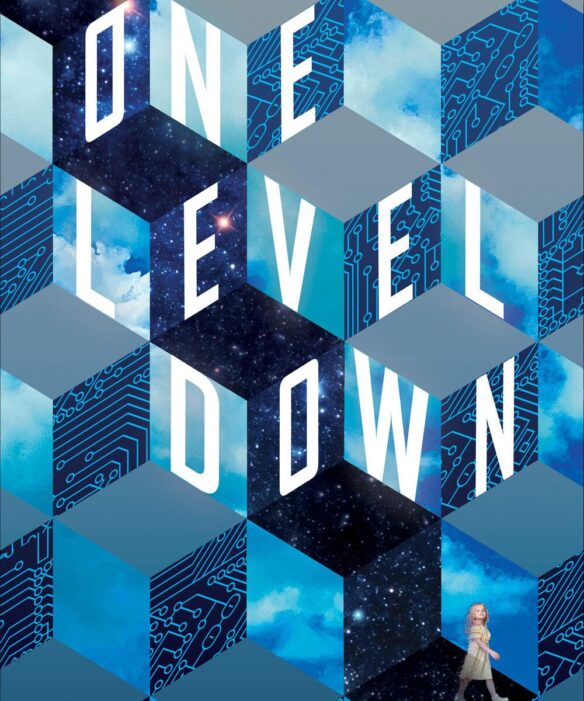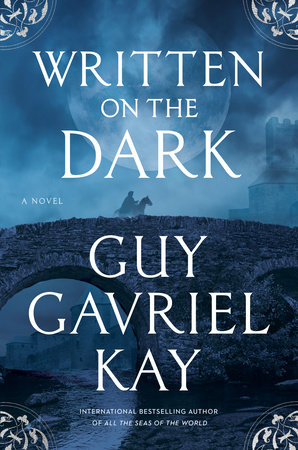
The Collected Stories of Roger Zelazny: Volume 6: The Road to Amber, Edited by David G. Grubbs, Christopher S. Kovacs and Ann Crimmins (NESFA, 2023)
Review by Paul Weimer: And so we come to the sixth and final volume of the NESFA Press collections of the works of Roger Zelazny. It is the end, but it has been prepared for, to quote the Fourth Doctor in Logopolis.
The amount of short fiction in these last years of Roger Zelazny is rather small. Both his health problems, and his focus on novels means that in terms of short fiction, this volume has the least of the six volumes in terms of short fictional material of the sort that has dominated the earlier volumes.
So let’s turn to that short fiction first. As the title, and people who know the bare outlines of Zelazny’s career can guess, this is the volume that collects all of the Amber short stories and other material that Zelazny wrote in and after the final Merlin novel of Amber. (There are a few other stories and works here as well, mind but Amber makes up more than half of the fiction in the book) Would these stories have been a springboard to a third series of Amber books? We’ll never know. Certainly, fan fiction writers and roleplayers (like myself) have used these stories as springboards and launching pads for roleplaying campaigns and other works.
Are the stories of interest to a reader not steeped in Amber? Honestly (and I say this as someone who I think you all know is pretty in deep in this stuff), probably not. The novels, as you know, feature Corwin (first series) and Merlin (second series) as singular points of view throughout their series. No breaking point of view, a strict close first person point of view. (In a way, the new enthusiasm for that in epic fantasy is, well, something Zelazny did decades ago)
These short stories break that convention. “The Salesman Tale” is from Luke’s perspective as he gets caught in Amber politics and makes a bargain with Vialle, Queen of Amber. “Blue Horse, Dancing Mountains” does return us to Corwin’s perspective, as he flees captivity in Chaos and gets mixed up in mysterious portents along the way. “The Shroudling and the Guisel returns us to Merlin’s perspective as he meets a childhood friend and deals with a extradimensional monster. “Coming to a Cord” is perhaps the most experimental of the lot, as it tells a story from the perspective of Merlin’s sapient artifact Frakir as they try to figure out mysterious events in the castle after being abandoned by Merlin.
“Hall of Mirrors”, the last and final story, has Corwin and Luke team up in the titular portion of the Castle, with even more dire portents, and mixes in Flora (seen in Coming to a Cord) in the bargain. There is also a map, an unusual ficlet of Amber written in collaboration with Ed Greenwood, the unpublished prologue to Trumps of Doom (where Merlin walks the Logrus, and first gets the aforementioned Frakir), and an Amber questionnaire which answers some questions about the Amberverse. It’s a decent chunk of the book, but again, in the end, if you don’t know who Rilga’s three sons are (1), or know whose symbol is a lion rending a unicorn (2), then these stories and bits and bobs are, I am afraid, not going to be a hit for you. They don’t stand alone, and aren’t meant to stand alone.
Fair enough. What else is here? More poetry (because the NESFA Press editors led by Kovacs have been so good as to sprinkle poetry from his entire career through the volumes). There are some interesting stories and curiosities as well. (Including an outline for what would become, with collaboration after his passing, the novel Donnerjack)
Of particular interest may be the remainder of the Croyd Crenson Wildcard stories and matter that Zelazny did in his lifetime, completing the collection of that work began in volume five. We get the character outline, which has been invaluable for people using the character ever since (Croyd is very popular in the Wild Cards universe), and the stories “Concerto for Siren and Serotonin” and the final story he did for Croyd, “The Long Sleep”.
There is also a surprising amount of work around the story Godson, which is about the godson of Death, and his unusual power and abilities as a result. I would have thought that maybe Pratchett was inspired by Godson in the creation of Susan in the Discworld novels, but I learned after reading the Godson material that there is an old Grimm’s fairytale about Godfather Death that Zelazny and Pratchett are both borrowing from. In addition to the story Godson, here, there is also a play adaptation of the story here, complete. The willingness of Zelazny to experiment and escape his own bounds by trying a play treatment of one of his stories just reinforces my conviction of his inventiveness and cleverness as a writer.
One of Zelazny’s finest short stories, “The Three Descents of Jeremy Baker” feels like, upon rereading (I read it long ago but forgot most of the details), as it is an inspiration for a particular scene in Interstellar. The story, about the eponymous space traveler trapped near a black hole and his attempts to escape his fate, is funny, poignant and amusing. It also occurs to me that Baker’s final fate also might tie into an idea that Gene Wolfe used in one of his later novels.
There is also the background and interstitial matter for Zelazny’s own attempt to do a shared world volume, Forever After. The conceit for Forever After is a good one–once the heroes have gathered all the magical geegaws, trinkets, tchotchkes and the like to defeat the Dark Lord (or Dark Lady, or Dark Being), what happens to them? Why are they found in such begotten places in the first place rather than gathered together? Zelazny’s idea is that having too many of the things in close proximity for too long turns out to be a bad thing. So, once the big bad is defeated, the magical artifacts have to be scattered all over again. And thus this anthology (which included David Drake, Jane Lindskold, Mike Stackpole and Robert Asprin) came to be. Zelazny provided the background and some interconnecting materials, the authors tells the story of the scattering of the artifacts again (and the consequences of doing so). It’s full of light fantasy humor (there is even a fight that is beat by beat a Three Stooges routine). And the whole idea feels like a deconstruction of fantasy quest narratives that could be published today (Django Wexler’s How to be the Dark Lord and Die Trying feels resonant with Forever After)
And then there are the remembrances and elegies. I’ve not really talked about these much in length in the previous volumes, but it is here that they hit, and hard. In particular, I was moved by the aforementioned Jane Lindskold’s piece simply titled “Roger Zelanzy “, which tells the story of their relationship in Zelazny’s last years of his life. I found it elegiac, moving and beautiful. Gerald Hausman and Gardner Dozois also have remembrances in this volume as well. However, Lindskold’s feels far more personal and real, and vital, and perhaps essential. While reading remembrances and elegies is something I am not wont to linger over, this one, giving perspective to the end of Roger’s life from Lindskold’s perspective, is the exception that proves the rule for me.
In some way, this volume, with those pieces, and the final pieces of Zelazny’s work, does make this volume both a wake and a celebration of life for Zelazny’s oeuvre. Certainly, the previous five volumes fit that role as well, but especially the early volumes felt more like an exploration of his earlier work, whereas where we come here, to the end of all things for Zelazny, it is a chance to read it to the end and think about, celebrate Zelazny’s work and his life, and mourn his too-early passing.
This is where we think about Zelazny in the main, in the complete, in the whole. I’ve highly enjoyed this exploration of his oeuvre, from its passionate and wild beginnings, through his phases of work, and here to the end. The biographies, poems, interstitial matter, curiosities and more have kept the books fresh and interesting. These have been far from being a dogmatic “death march” through his work. The six NESFA Press volumes of the Collected Work of Roger Zelazny have been a joyous shadowshift, and sometimes a glorious hellride, through the multitudinous worlds of Zelazny’s work. The journey has been the destination, even as this volume evokes Nine Princes of Amber and Corwin and Random driving toward the city, worlds changing as they go.
So we come to the end of this book, and the six book series. (There is a seventh book that is strictly a bibliography, The Ides of Octember.) As for me on a personal note, now that I have completed the Zelazny NESFA Press volumes, I look to move on to another heart author with a sheaf of NESFA Press books, and another of my heart authors, Poul Anderson.
So, to quote Corwin at the end of The Courts of Chaos:
“Hello, and goodbye, as always”
Footnotes.
(1) Gerard, Caine and Julian
(2) Dalt, son of Deela and Oberon. The character in my RPG scenarios and campaigns that players just love to hate.













